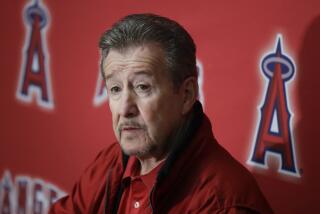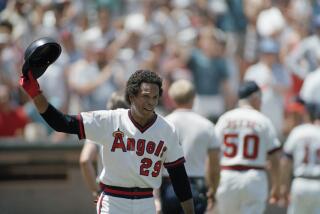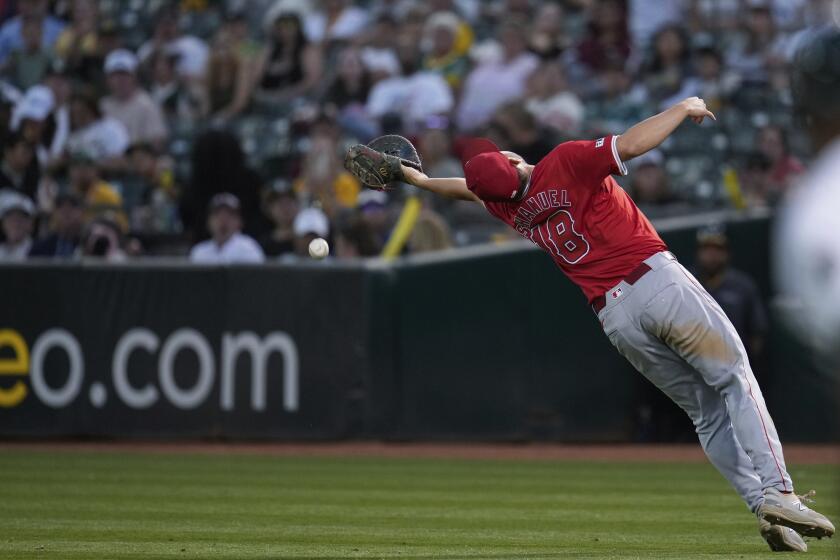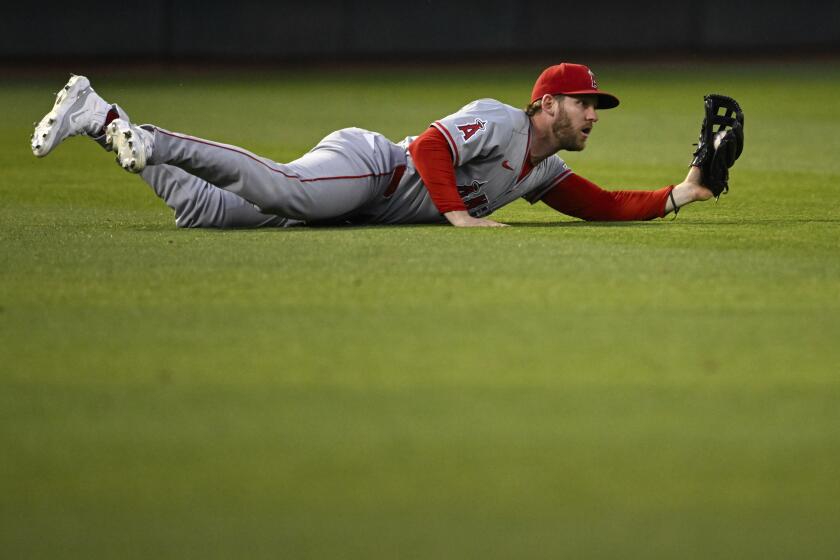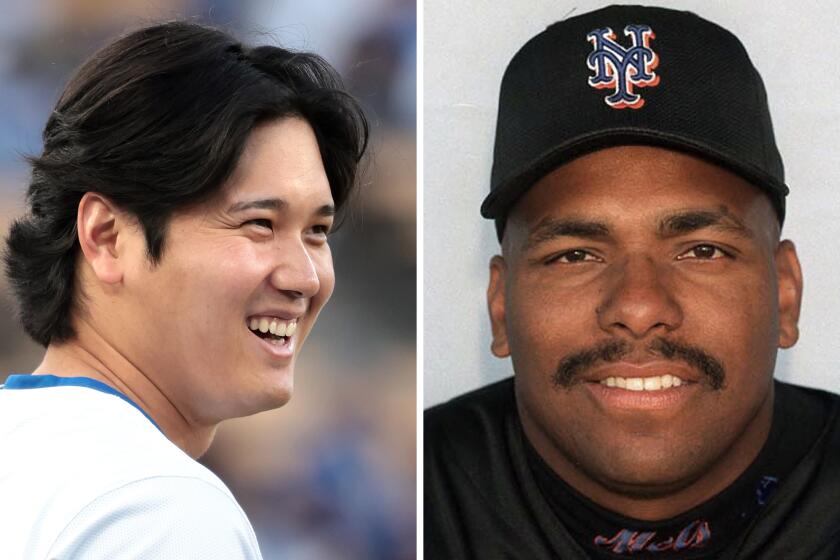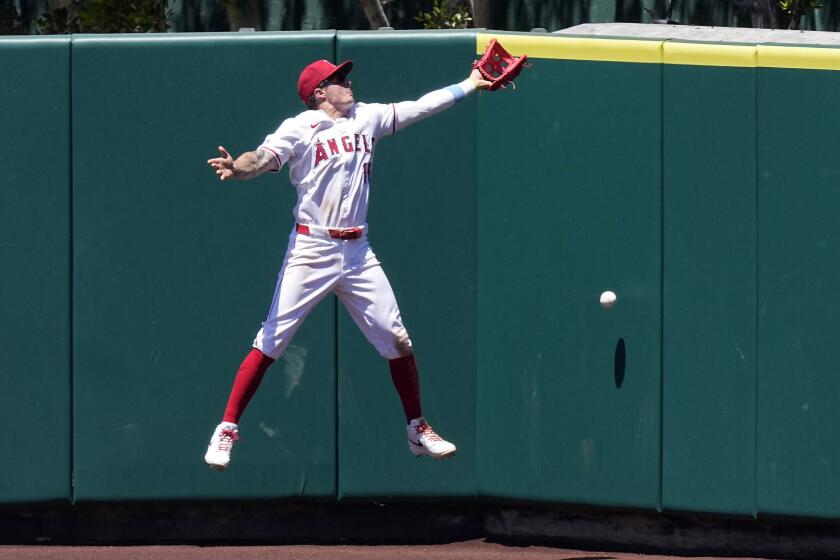
A massive stuffed frog sat in the gift shop of an arcade at Knott’s Berry Farm. A young Tawyna Johnson Hesse, visiting her uncle, Arthur Johnson, in Southern California one summer, was determined to get it.
So was Uncle Art. That day, he took her around the arcade for three hours, bouncing from game to game until they turned enough money from real to fake to earn that massive stuffed frog. On her flight home to Northern California, she practically needed a separate seat for the thing.
She said Uncle Art was full of life. Full of mischief. Johnson Hesse was close enough with him that she chose to go to college at Cal State Fullerton to be near him. Once a week, he’d pick her up to go buy groceries.
In her uncle’s later years, Johnson Hesse was the one doing his grocery shopping. She cleaned his house, hired caregivers, did his laundry. Macular degeneration made it difficult for him to go out.
It made it difficult, too, for him to follow his Angels, the baseball team he’d loved since they played their first game in 1961. He couldn’t attend games in person. Couldn’t even watch them on television. But he’d still turn on every game to listen.
Before Art died in 2013, Johnson Hesse and family told him about an idea to buy a personalized brick for him to be placed outside Angel Stadium. He thought it was clever. They didn’t get a chance to do it while he was alive, so they got it a year after his death.
“This is kind of like our little — kind of like the gravestone.”
— Tawnya Johnson Hesse on the Angel Stadium brick dedicated to her uncle, Art Johnson

The first time she saw it embedded in the front plaza, the message “Uncle Art — R Angel” imprinted amid a maze of other inscribed bricks, Johnson Hesse cried.
“This is kind of like our little — kind of like the gravestone,” she said.
Fans rushing to the home-plate entrance of Angel Stadium might not notice it. They might not notice the hundreds of other names, grouped in neat squares, among the greenish-gray diamond outside the front gate.
But for a select group, each brick in that maze, like Art Johnson’s, tells a unique story of love for the Angels. One that often begins with an innocent, childhood passion. One that continues with family. One that will end with a lasting fandom, burning so bright that loved ones wanted to permanently etch their names into the very foundation of Angel Stadium.
::
An average gravesite headstone, depending on quality, might cost around $1,000. But engraved 4-by-8-inch bricks at Angel Stadium cost just over $100.
After the stadium was renovated in 1997, which led to the implementation of the stone diamond near the home-plate entrance, the personalized brick program was created in the early 2000s. According to Adam Cali, manager of foundation and community initiatives for the Angels, the original idea behind the concept was to give fans a permanent piece of the stadium to hold on to.
“Over the years, the Angels have tried to make ourselves a family-friendly organization,” Cali said. “Bringing families here to the ballpark and giving them the opportunity to put their name on literally like, a stone that’s part of the foundation of the team, it definitely gives them that strong attachment.”
Or rather, cements it.
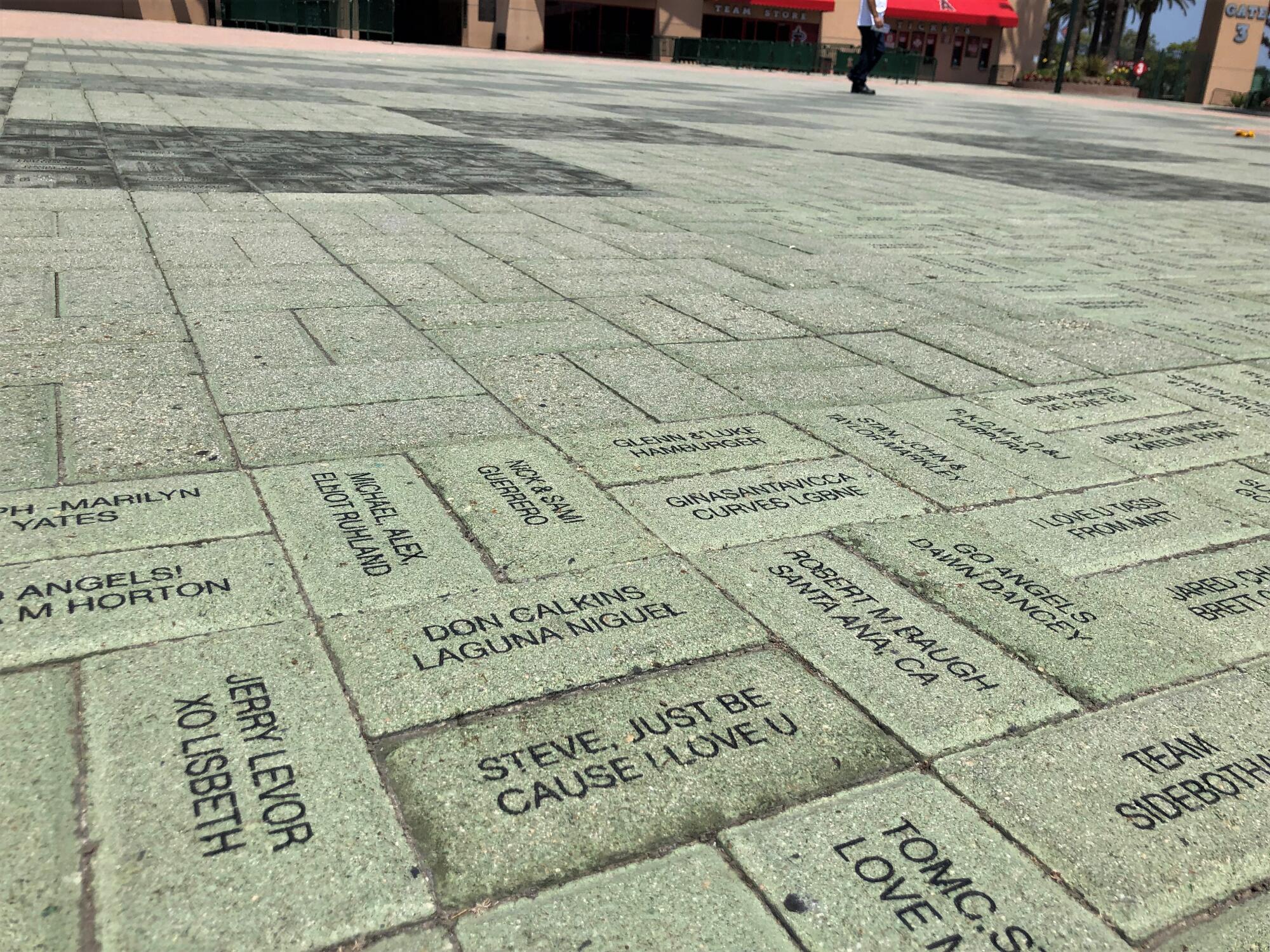
It is uncertain how long the bricks might remain in front of a stadium. Angels owner Arte Moreno has the right to renovate or replace as part of a $150-million deal through which his development company bought the stadium and surrounding parking lots.
It’s too early to pinpoint plans, Angels spokesman Adam Chodzko said. While Cali and his staff have amassed a comprehensive catalog, it’s also too early to pinpoint plans for the bricks in the event of a significant remodeling.
“The idea of throwing them out — I just, I don’t see that,” Chodzko said.
::
Nowadays, David Breech works at an appliance store in Wisconsin. He’s lived there since 2000 and hasn’t been to an Angels game since 1989. But he’s never stopped being a fan after growing up a few miles from Angel Stadium.
The reason? Nolan Ryan.
On May 15, 1973, Breech said his father, Ronald, burst into his room.
“Get out here,” the elder Breech said. “You’ve got to come watch something.”
An Angels game, now in the late innings, was flickering on the television. On the mound was Ryan, in the midst of pitching the first no-hitter of his illustrious career.
Breech, 11 at the time, wasn’t much into baseball. He was a football fan. But the significance of the game lit a spark in him.
Two months later, Ryan threw another no-hitter. Breech’s father was out in the garage trying to fix his daughter’s Volkswagen. This time, Breech was the one to rush into the room.
“Dad, I think Nolan Ryan’s going to pitch a no-hitter!” Breech said he exclaimed.

“No, that ain’t happening,” his father said. “Nobody ever pitches two in a year.”
Breech said he dashed back inside, unplugged his older sister’s smaller, portable TV, went back to the garage, plugged it in and said, “See, he is!”
Thirty-two years later, Ronald Breech died. He was cremated, and the younger Breech didn’t have a place to spread his ashes. So a month later, Breech had the idea to place a brick at Angel Stadium in remembrance of his father.
It reads “Ronald Breech / Thank You Dad.” The thank you, in part, is for inspiring Breech’s love of baseball.
::
Growing up in the 1960s, Bradley Hyman’s family lived on State College Boulevard in Anaheim in a house his father, Hal, bought for $14,000 on a teacher’s salary. They were surrounded by acres upon acres of orange trees, Hal remembers. Then a ballpark dropped into their lap.
Construction of Angel Stadium finished in 1966, and their first game was an exhibition against the San Francisco Giants. Hal got tickets from a fellow teacher, told his son they were going, and running to the ballpark after his dad got off work soon became routine for Hyman.
In the franchise’s early years, crowds weren’t big. A stadium that could accommodate 40,000 people rarely held 10,000. After biking to the stadium and getting in with a general admission ticket that cost $1.50, Hyman said he would sneak down to the field level and watch near the dugout.
Sometimes he’d get in a word or two with players on the field — his neighbors. Many Angels in the 1970s — Jim Fregosi, Bobby Knoop, Clyde Wright among them — lived nearby. Hyman went to school with their kids.
“You would see them mowing the lawn, and maybe playing catch out front,” Hyman said of the players. “Especially back then, they weren’t making a lot of money, so they were living in regular tract homes … they were regular guys.”
What Hyman cherishes most about that time is the foundation it built with his father, sharing in warm days at the ballpark. Without it, they might have lost touch.
“Hopefully, he’ll live quite a few more years. But one day, when he’s gone, hopefully that brick will still be there.”
— Bradley Hyman on his father Hal’s brick at Angel Stadium
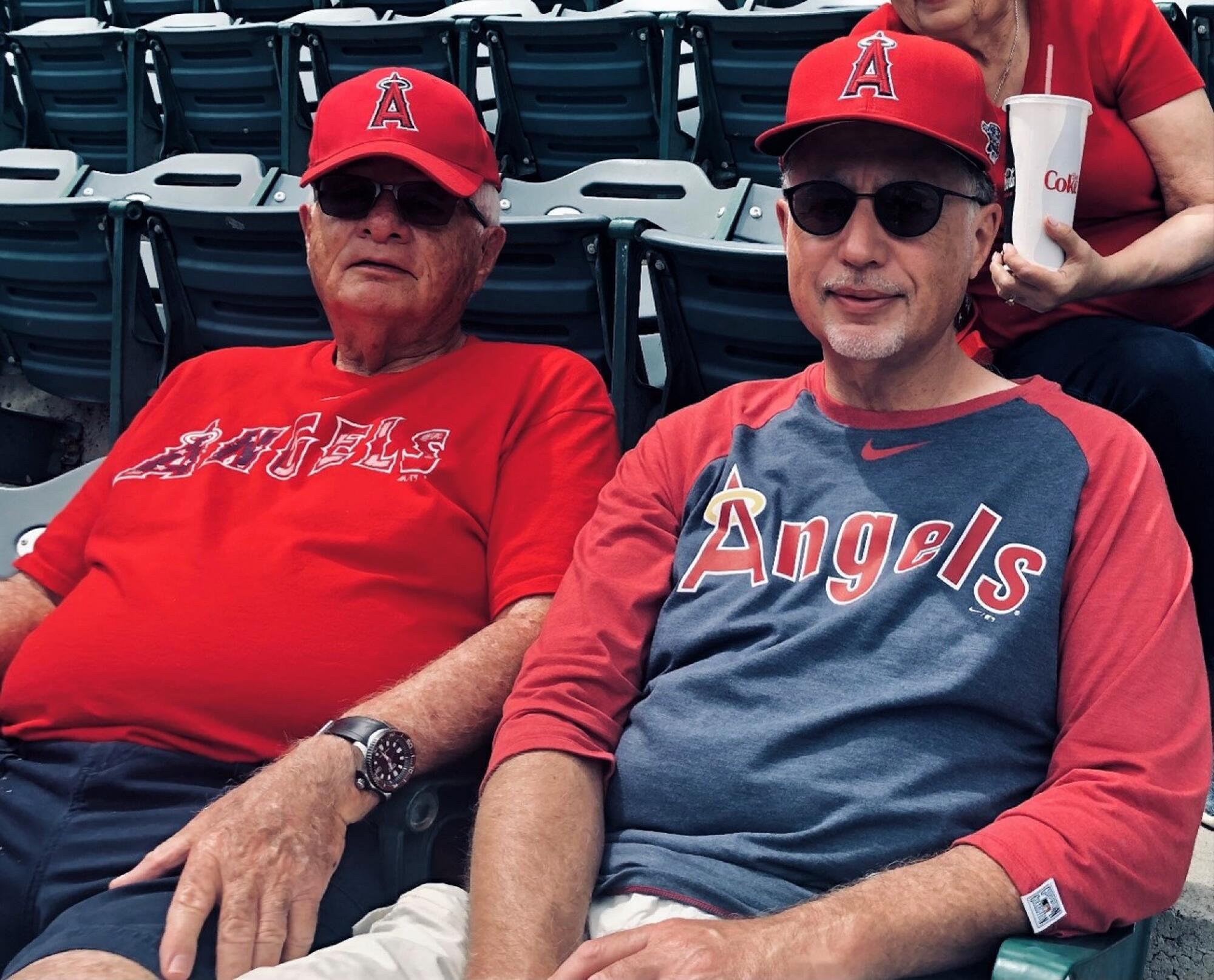
In the middle of his life, Hyman struggled with alcoholism. He and his dad drifted apart, the disease rubbing against their bond until it loosened.
But Hal, in a constant struggle to help his son, always had a tool in his back pocket.
“One way that my dad could check on me was to ask about Angels baseball,” Hyman said. “I have a feeling he thought if I didn’t know if the Angels won or lost the day before, then something was seriously wrong.”
At times, it was the strongest bond between them, Hyman felt. Through thick and thin, through the times they didn’t want to talk about the heavy stuff, there were those Angels.
Hyman is now 23 years sober, and says he and his father have never been closer. They talk on the phone every day, always starting with a discussion of Angels baseball.
To this day, if Hyman goes to a game and sees a father sitting with a child, he’ll tell them he and his father, at ages 62 and 86, still go to games together. And it’s an experience he hopes they, too, will share for 50 years.
Hyman and his family, before every game, always spend time searching among the maze for Hal’s brick.
“Hopefully, he’ll live quite a few more years,” Hyman said of his father. “But one day, when he’s gone, hopefully that brick will still be there.”
::
Reed Nakakihara, a Tustin resident whose aunt and uncle bought him a brick when he was 12 in 2009, hopes to take his kids to the stadium one day to see his name etched into the ground.
“It definitely gives me something, like a piece of me or a piece of home is there,” Nakakihara said.
Doug Rundquist, who went to 50 games one season in the 1980s and owns a brick that says “Fan since ‘73,” suggests building them into a wall in the event of a significant stadium renovation.
“If they were to not use any of the bricks again, it would kind of be a slap in the face because it would be disregarding the memory of those fans,” Rundquist said.
Johnson Hesse has often thought about what would happen to that plaza if the stadium was rebuilt. She said it’s comforting to have that memory of her uncle there. It’s the closest thing to scattering his ashes directly on the field.
“I hope years from now my kids, they go to Uncle Art’s brick,” she said. “I hope they teach their kids to go to Uncle Art’s brick as well.”
More to Read
Go beyond the scoreboard
Get the latest on L.A.'s teams in the daily Sports Report newsletter.
You may occasionally receive promotional content from the Los Angeles Times.
